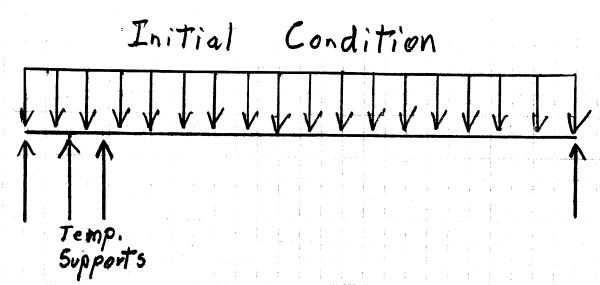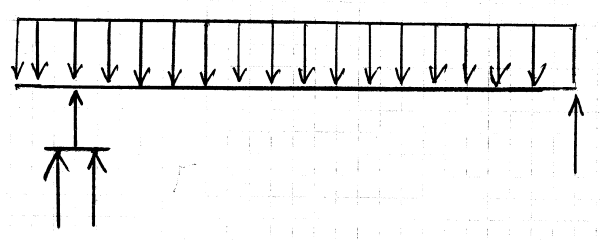Temporaryworks
Structural
Hi,
I have a question regarding the effect that spacing of temporary propping has on how much load those props attract. To give you some context to the question, please see attached sketch and read below:
- A 6m wide pedestrian bridge spanning 6.5m is supported between an elevated pedestrian concourse and the 1st floor of a building.
- The bridge will be saw cut where the bridge meets the concourse and then the concourse will be demolished. The bridge will be retaining for a while hence the need to isolate and support it.
- I have been tasked with designing temporary propping at the concourse end to take the self-weight of the bridge. On the other side the bridge is still supported by the building, thus the props are only required at one end.
- The bridge is a reinforced concrete one, spanning approx 6.5. It has been formed of two beams approx 0.5m deep x 0.3m wide which do the spanning and then a slab spans the other way between the beams to form the walkway.
- I plan to prop the beams at the end that requires support with 2no props on each beam - 4no in total.
If I butt the props up together I can assume that they will take half the load each).
If I then space these props out 500mm from each other so that they can be braced to each other and to the 2no props on the other side to provide stability, can I still assume that they act together? Or will the inside prop take significantly more load (see attached for dims).
I think that that the answer has something to do with the stiffness and the deflected shape of the beam.
Thanks in advance,
Temporaryworks
I have a question regarding the effect that spacing of temporary propping has on how much load those props attract. To give you some context to the question, please see attached sketch and read below:
- A 6m wide pedestrian bridge spanning 6.5m is supported between an elevated pedestrian concourse and the 1st floor of a building.
- The bridge will be saw cut where the bridge meets the concourse and then the concourse will be demolished. The bridge will be retaining for a while hence the need to isolate and support it.
- I have been tasked with designing temporary propping at the concourse end to take the self-weight of the bridge. On the other side the bridge is still supported by the building, thus the props are only required at one end.
- The bridge is a reinforced concrete one, spanning approx 6.5. It has been formed of two beams approx 0.5m deep x 0.3m wide which do the spanning and then a slab spans the other way between the beams to form the walkway.
- I plan to prop the beams at the end that requires support with 2no props on each beam - 4no in total.
If I butt the props up together I can assume that they will take half the load each).
If I then space these props out 500mm from each other so that they can be braced to each other and to the 2no props on the other side to provide stability, can I still assume that they act together? Or will the inside prop take significantly more load (see attached for dims).
I think that that the answer has something to do with the stiffness and the deflected shape of the beam.
Thanks in advance,
Temporaryworks



![[idea] [idea] [idea]](/data/assets/smilies/idea.gif)
![[r2d2] [r2d2] [r2d2]](/data/assets/smilies/r2d2.gif)